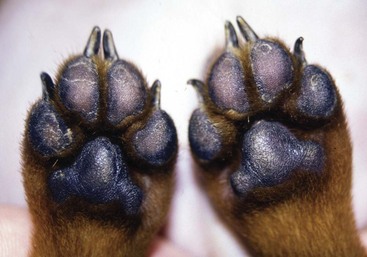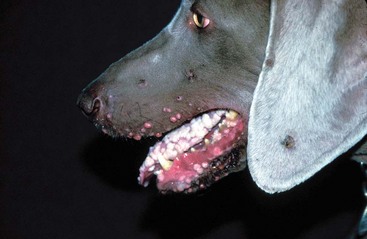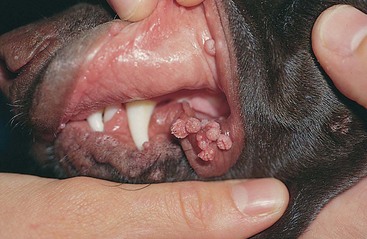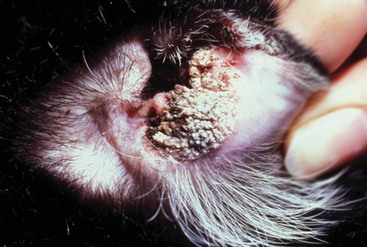CHAPTER | 6 Viral, Rickettsial, and Protozoal Skin Diseases
Canine Distemper
Diagnosis
2 Immunocytology or polymerase chain reaction (PCR) technique (blood, nasal or ocular discharge, saliva, conjunctival scrapings, cerebrospinal fluid [CSF]): detection of distemper antigen.
3 Dermatohistopathology (affected footpads): nonspecific changes include orthokeratotic hyperkeratosis, irregular acanthosis, thickened rete ridges, and mild mononuclear perivascular and periadnexal dermatitis. Intracytoplasmic eosinophilic viral inclusion bodies and ballooning degeneration may not be seen.
Treatment and Prognosis
2 Supportive care should be provided and oral or parenteral broad-spectrum antibiotics administered to prevent secondary bacterial infection.
3 The prognosis is poor for dogs with nasodigital hyperkeratosis. Canine distemper is contagious to other dogs, but not to cats or to humans.
Papillomas
Features
Diagnosis
1 Dermatohistopathology: epidermal hyperplasia and papillomatosis with ballooning degeneration of epidermal cells, variably present intranuclear inclusion bodies, and prominent keratohyaline granules.
Treatment and Prognosis
1 Most papillomavirus infections regress spontaneously after development of host cell–mediated immune response.
2 Surgery may be curative for persistent solitary lesions, but care should be taken with tissue handling to avoid seeding the surgical site with viral particles.
4 Azithromycin, 5–10 mg/kg PO q 12–48 hours dogs and cats, has demonstrated variable success and has minimal adverse effects.
5 Interferon, 1.5–2 million units/m2 subcutaneously three times weekly for 4 to 8 weeks (2 weeks beyond clinical cure), has been anecdotally successful in cases of oral or cutaneous viral papilloma in dogs and cats.
6 Anecdotally, 5% imiquimod cream applied topically every 24 to 48 hours until the lesion regresses has been used successfully in cases of canine cutaneous papilloma and feline Bowen’s disease. An Elizabethan collar should be placed on the animal to prevent licking and medication ingestion.
7 Autogenous vaccines and immunomodulating agents (e.g., levamisole, thiabendazole) are of undocumented efficacy.
8 A new recombinant canine oral papillomavirus vaccine (COPV) produced by Georgetown University Medical Center shows promise for treatment of refractory canine oral papillomas. It consists of the major capsid protein L1 of the COPV. In the single published case report, six vaccinations were administered subcutaneously in the interscapular region. The first three boosters were administered every 2 weeks, and the last two were administered monthly. The oral papillomas regressed completely by the time the last treatment was administered, with no recurrence after 60 months.
9 Oral retinoids (i.e., acitretin 0.5–1 mg/kg PO q 24 hours) have been reported to be beneficial in one case each of canine inverted papilloma and canine pigmented plaques.
10 Antimetabolites can be used to inhibit DNA synthesis and proliferation. Topical application of 0.5% 5-fluorouracil (5-FU) solution every 24 hours for 5 days, then every 7 days for 4 to 6 weeks for cutaneous disease (dogs only). An Elizabethan collar should be placed on the dog to prevent ingestion of the medication, and the owner should wear latex gloves. Contact dermatitis or systemic toxicities are possible.
11 The prognosis is usually good, as most cases will spontaneously regress. Malignant transformation to squamous cell carcinoma is possible with canine pigmented plaque and feline multiple viral papilloma, and in rare cases of oral and corneal papilloma.
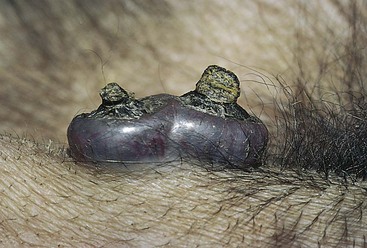
FIGURE 6-5 Papillomavirus.
Cutaneous horns are protruding from the papillomas on the abdomen of this 6-month-old dog.
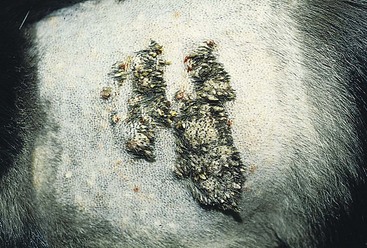
FIGURE 6-6 Papillomavirus.
A large papillomatous plaque on the lateral thorax of an adult German shepherd.
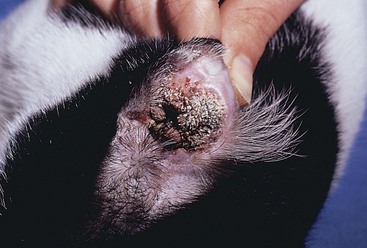
FIGURE 6-7 Papillomavirus.
Multiple papillomas formed a plaque on the ear of this cat.
(Courtesy of A. Yu.)









